NIMSCAST 2008 vs 2007 Local collection comparison
NIMSCAST 2008 vs 2007 Local change explanation 1660-0087.doc
National Incident Management System Compliance Assistance Support Tool (NIMSCAST)
NIMSCAST 2008 vs 2007 Local collection comparison
OMB: 1660-0087
2
The information below lists the 2008 NIMSCAST question first, then the corresponding question from 2007 is pasted afterwards. Then an explanation of any changes occurs in the space just below the 2007 question. When no changes were made or a question was added or deleted, it is so indicated.
2008 Section 1 Question 1.1





2007 Section 1 Question 1

2008 paraphrases the question of 2007 with slight changes. The phrase “tribal/local” has become “State/Territory”. Both ask for responders to indicate which legal authority is used to implement NIMS, but only 2007 gives a checklist on the issue of impediments
that would hinder the implementation of NIMS.
2008 Section 1 Question 2

2007 Section 1 Question 2

This is a completely new question which does not appear in 2007. 2008 asks if the adoption on NIMS expires in Question 1.2, while Section 1 of 2007 isn’t divided into three separate questions as in 2008. Therefore, no Question 1.2 appears in 2007.
2008 Section 1 Question 3

2007 Section 1 Question 3


Section 1.3 of 2008 shortens the question of 2007 and eliminates the check chart given to respondents to indicate groups and methods. It also eliminates the impediments checklist.
2008 Section 2 Question 1

2007 Section 1 Question 3

2008 Section 2 Question 1 paraphrased the question of 1.3 in 2007.
2007 provides a brief form in order that respondents answer questions about the “Designee”. 2008 asks the same questions without the form.
2008 Section 2 Question 2

The above question of 2.2 of 2008 has no counterpart in 2007.
It is a new inquiry specifically added to 2008.
2008 Section 3 Question 1

2007 Section 3 Question 2
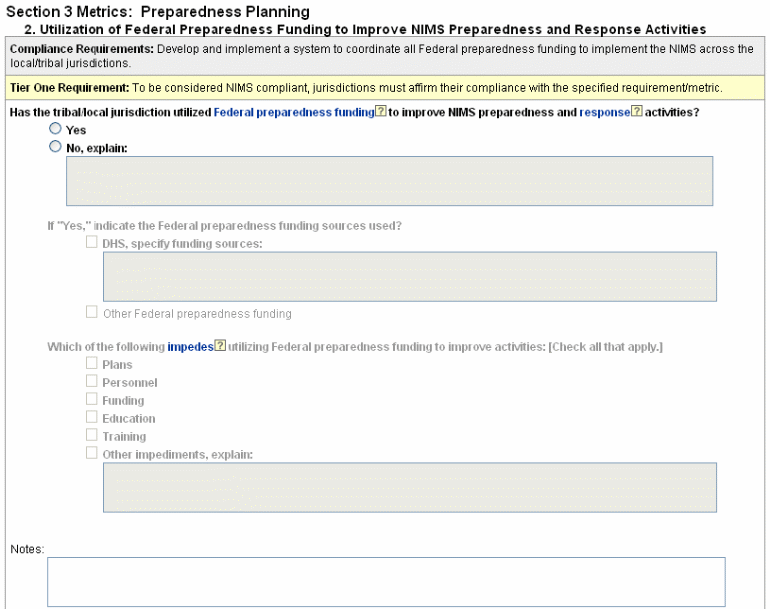
Question 3.1 of 2008 was previously Question 3.2 of 2007. The question has been shortened to one inquiry while that of 2007 divides the question into three separate inquiries. The term, “awards” in 2008 was changed from the term, “funding” in 2007.
2008 Section 4 Question 1

The above question of 4.1 of 2008 has no counterpart in 2007.
It is a new inquiry specifically added to 2008.
2008 Section 5 Question 1

2007 Section 3 Question 3
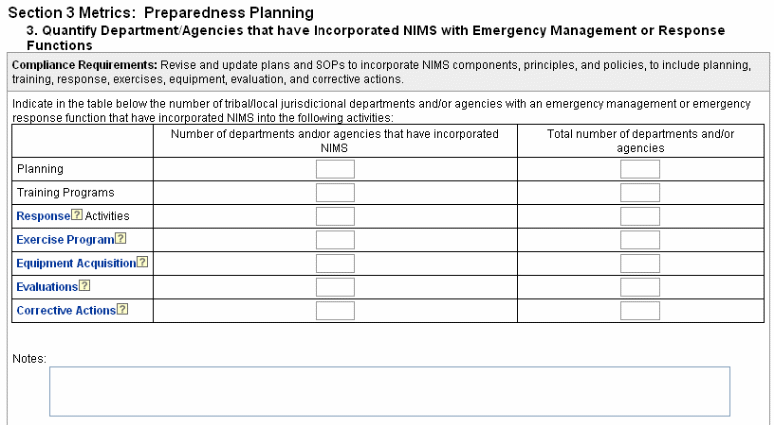
Question 5.1 of 2008 has removed the information table of 2007 for a smaller table and a shortened and/or paraphrased question. Also, Section 3 of 2007 doesn’t correspond to Section 3 of 2008. It has changed to Section 5 while questions 3.1 & 3.2 2007 have been completely eliminated. Therefore, 2007 begins at question 3.3 corresponding to 5.1 of 2008.
2008 Section 5 Question 2

2007 Section 3 Question 3

Question 5.2 of 2008 has removed the information table of 2007 for a smaller table and a shortened and/or paraphrased question. Again, Section 3 of 2007 doesn’t correspond to Section 3 of 2008. As before questions, 3.1 & 3.2 of 2007 have been completely eliminated. Therefore, 2007 begins at question 3.3 corresponding to 5.2 of 2008.
2008 Section 6 Question 1
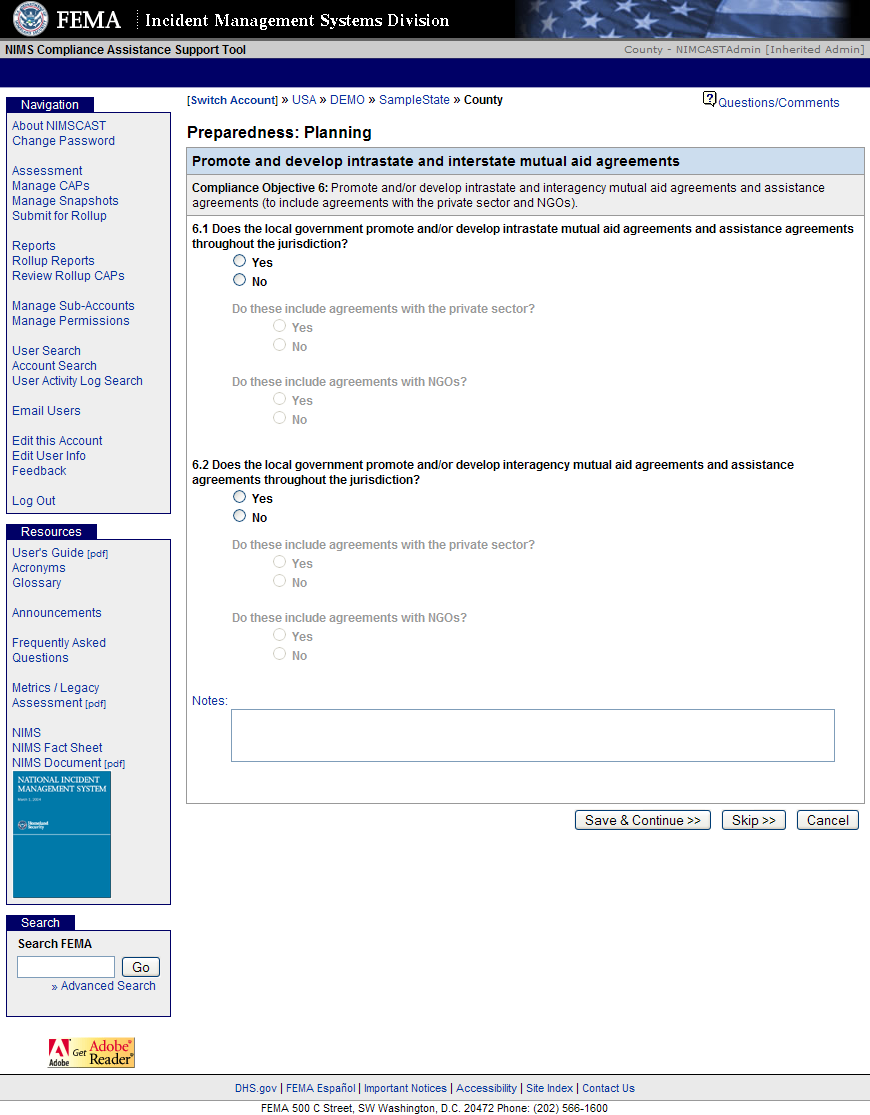
2007 Section 3 Question 5

2007 Section 3 Question 6

Question 1 of Section 6 in 2008 shortens the inquiry as represented by two sections in 2007. The sections include Questions 5 & 6 of Section 3. 2008 is revised with a shorter option list for respondents.
2008 Section 6 Question 2

2007 Section 3 Question 7

As before, 2008 Section 6 Question 2 shortens the inquiry as represented in 2007 Section 3 Question 7. The main difference is the removal of the extensive option list for respondents. Both 2007 & 2008 focus attention to the concerns of private sector and NGO involvement in mutual aid agreements.
2008 Section 7 Question 1

2007 Section 4 Question 2

2008 Section 7 Question1 has changed the wording of 2007 Section 4 Question 2.
Though the revised version of 2008 seems to ask a different question, it is the question which best corresponds to 2007 Section 4 Question 2.
2008 Section 8 Question 1

2007 Section 4 Question 1

The format for the table has been changed in 2008 to an abbreviated form from 2007.
2007 presents a table of five vertical columns, while 2008 presents a table of one vertical column. 2008 focuses specifically on course IS-700, but doesn’t mention courses IS-800,
ICS-100, ICS-200, ICS-300 and ICS-400 as does Section 4 Question 1 of 2007.
2008 Section 8 Question 2

2007 Section 4 Question 1

While 2008 Section 8 Question 2 deals specifically with course IS-700, Section 4 Question 1 of 2007 is more extensive in listing courses in a table.
2008 Section 9 Question 1

2007 Section 4 Question 1

2008 Section 9 Question 1 deals more specifically with course IS-800 while excluding the other courses listed in the table of 2007 Section 4 Question 1.
2008 Section 9 Question 2

2007 Section 4 Question 1

2008 Section 9 Question 2 deals more specifically with the issue of the local government documenting the training status of personnel in relation to course IS-800 while excluding the other courses listed in the table of 2007 Section 4 Question 1.
2008 Section 10 Question 1
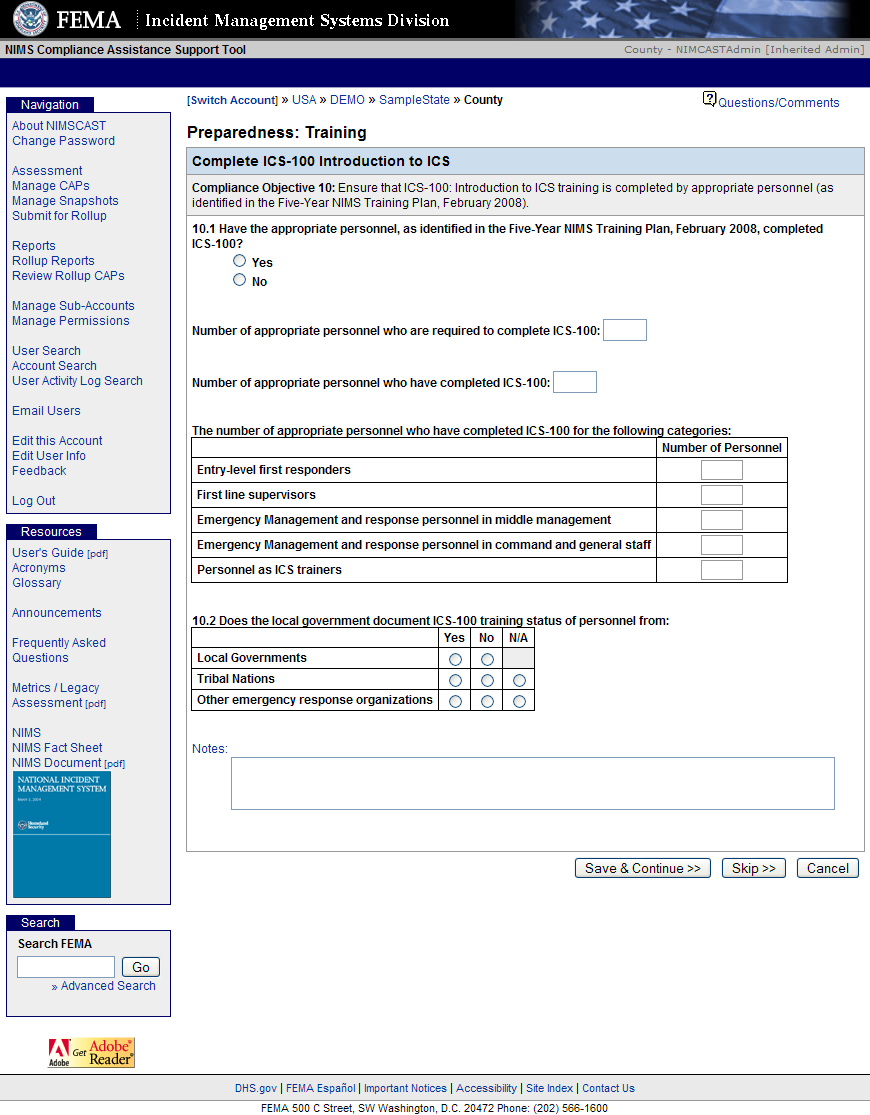
2007 Section 4 Question 1

2008 Section 10 Question 1 deals specifically with the issue of personnel completing training course ICS-100. A vertical display of options is given in 2008.
2007 is more inclusive in listing training courses. Respondents are given a horizontal display instead of a vertical one.
2008 Section 10 Question 2

2007 Section 4 Question 1

2008 Section 10 Question 2 departs from the extended table given in 2007 Section 4 Question 1. Again, the subject matter pertains to training course ICS-100.
This time respondents are asked to indicate which type of organization, whether government of private, represent the number of personnel participating in the course.
Again, the table of 2007 is more inclusive of other training courses in its listing.
Respondents are given broader columns with cells to place responses.
2008 Section 11 Question 1

2007 Section 4 Question 1

2008 Section 11 Question 1 concerns the completion of training course ICS-200 by appropriate personnel. It gives an answer table for respondents concerning five descriptive categories of completion. 2008 departs from the more extensive table of 2007 which lists additional training courses.
2008 Section 11 Question 2

2007 Section 4 Question 1

2008 Section 11 Question 2 deals with the documentation of personnel involved with training course ICS-200 by local governments, tribal nations and other emergency response organizations. This departs from the five column display table of 2007, which lists a number of coursed and not just ICS-200.
2008 Section 12 Question 1
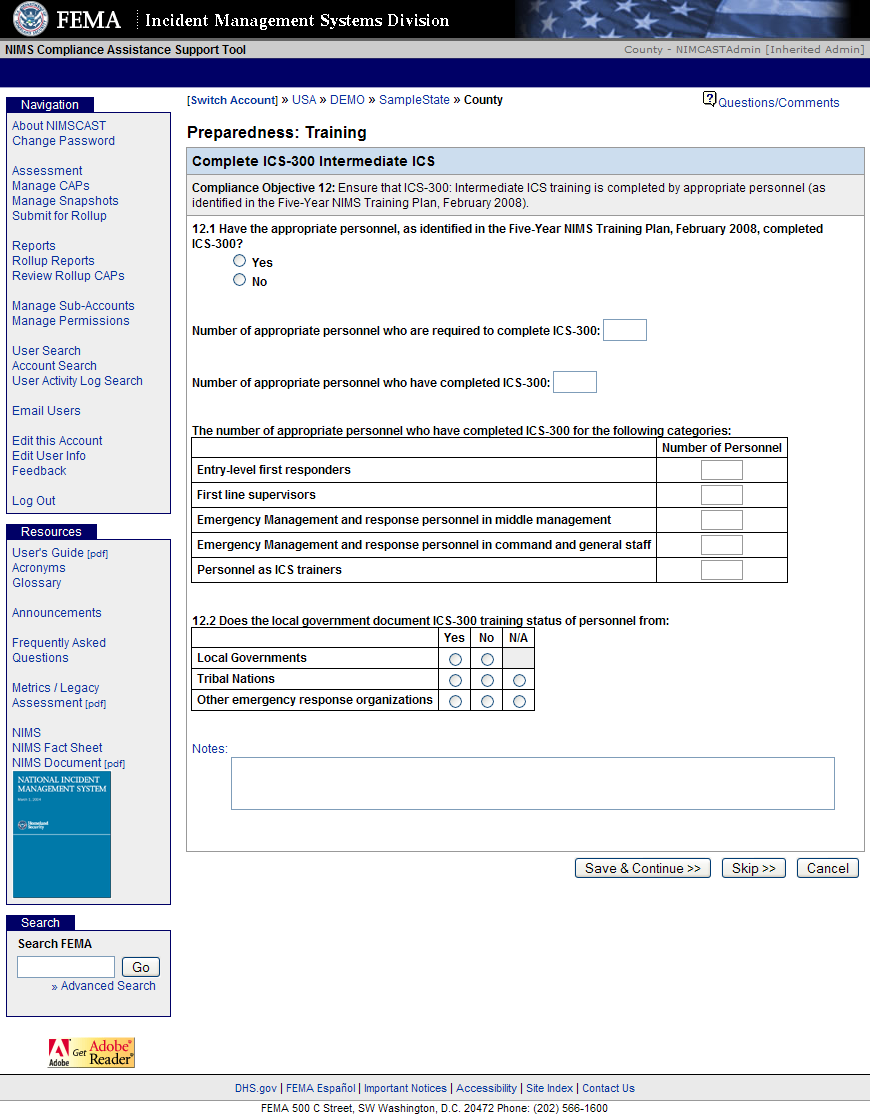
2007 Section 4 Question 1

2008 Section 12 Question 1 concerns the completion of training course ICS-300 by appropriate personnel. It gives an answer table for respondents concerning five descriptive categories of completion. 2008 departs from the more extensive table of 2007 which lists additional training courses.
2008 Section 12 Question 2


2007 Section 4 Question 1

2008 Section 12 Question 2 has been extended in scope to the concern of government documentation of personnel participating in training courses ISC-300 and ISC-400
2008 departs from the less extensive table of 2007 which lists additional training courses.
2008 Section 13 Question 1

2007 Section 5 Question 1

2008 Section 13 Question 1 lists eight concepts that respondents must indicate incorporation or non-incorporation in reference to NIMS principles and appropriate training. This departs from the format of 2007 Section 5 Question 1 which asks respondents to indicate the level of training and exercises.
2008 Section 13 Question 2

2007 Section 5 Question 1

2008 Section 13 Question 2 lists eight concepts that respondents must indicate incorporation or non-incorporation in reference to NIMS principles and appropriate exercises. This departs from the format of 2007 Section 5 Question 1 which asks respondents to indicate the level of training and exercises.
2008 Section 14 Question 1
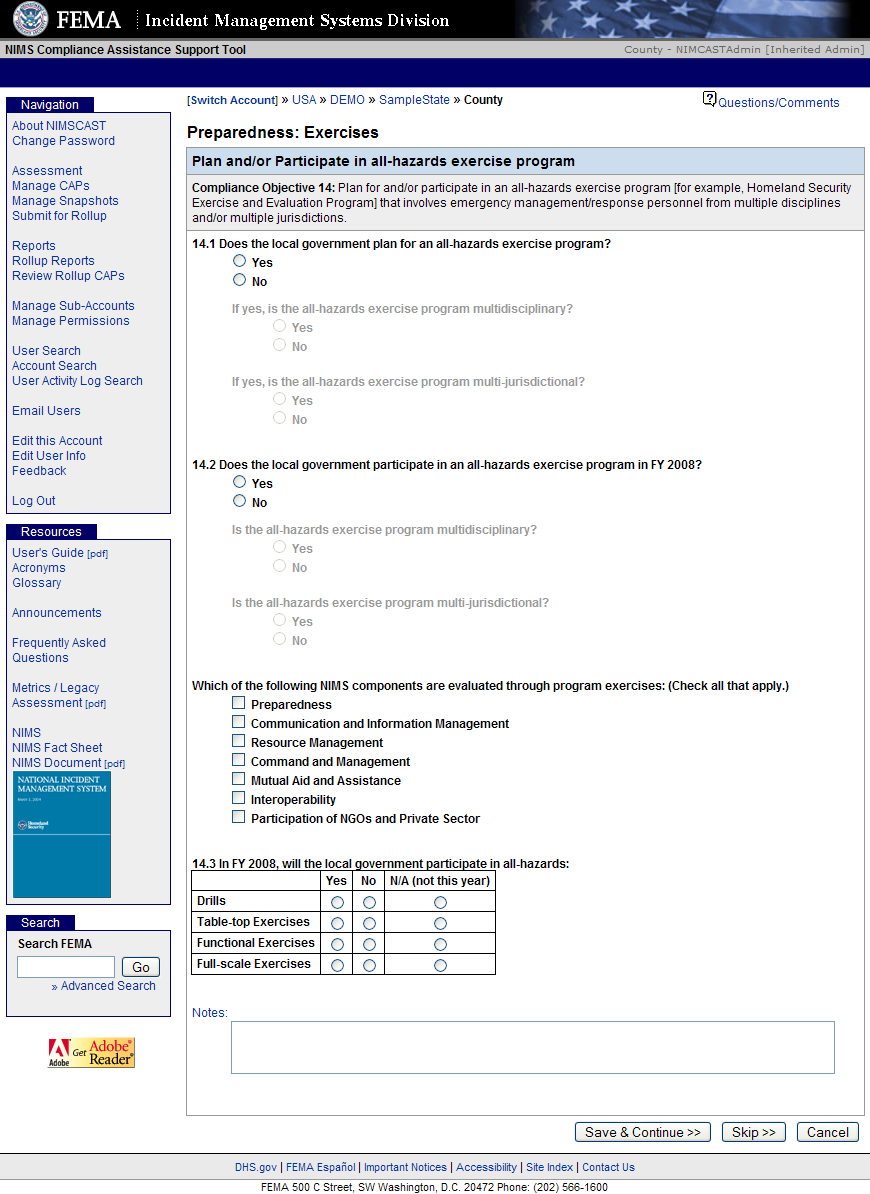
2007 Section 5 Question 3

2008 Section 14 Question 1 differs from 2007 Section 5 Question 3 in that a more extensive option checklist is given under the category, “No” for 2007.
2008 asks for no reasons that impede an all-hazards exercise program.
Instead, 2008 asks if the program is multidisciplinary & multi-jurisdictional.
2008 Section 14 Question 2

2007 Section 5 Question 2
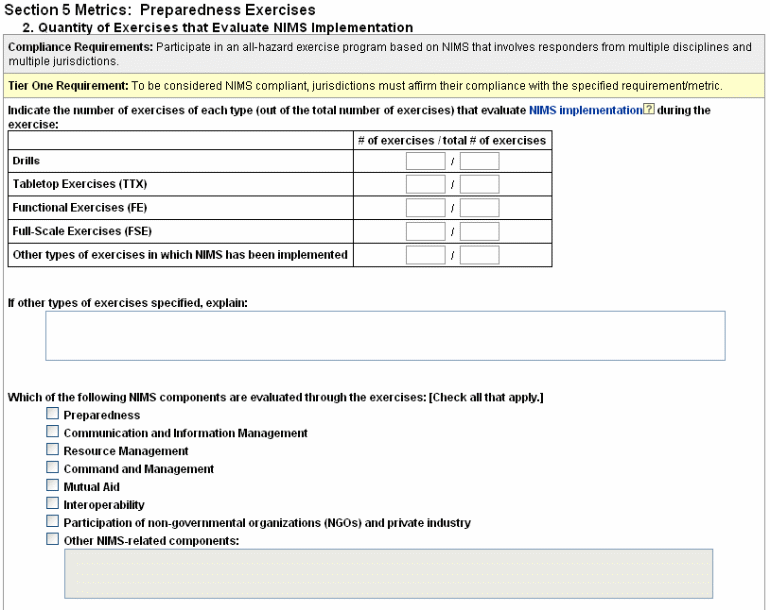

The brief question of 2008 differs in scope from the more expansive inquiry of 2007.
While 2008 Section 14 Question 2 is primarily concerned with the government’s participation in the all-hazards exercise program, 2007 Section 5 Question 2 is more concerned with exercise type, more specifically, the number of exercises of each type that evaluate NIMS Implementation.
2008 Section 14 Question 3

2007 Section 5 Question 2

The question of 2008 concerns itself with the participation of the government in the
all-hazards program in FY2008, While 2007 focuses on the quantity of exercises that evaluate NIMS implementation.
2008 Section 15 Question 1

2007 Section 5 Question 6

2008 Section 15 Question 1 has been shortened from the inquiry of 2007.
While 2008 asks about the incorporation of corrective action plans and after action reports, 2007 is more extensive, covering these concerns and issues that may impede incorporation.
2008 Section 16 Question 1
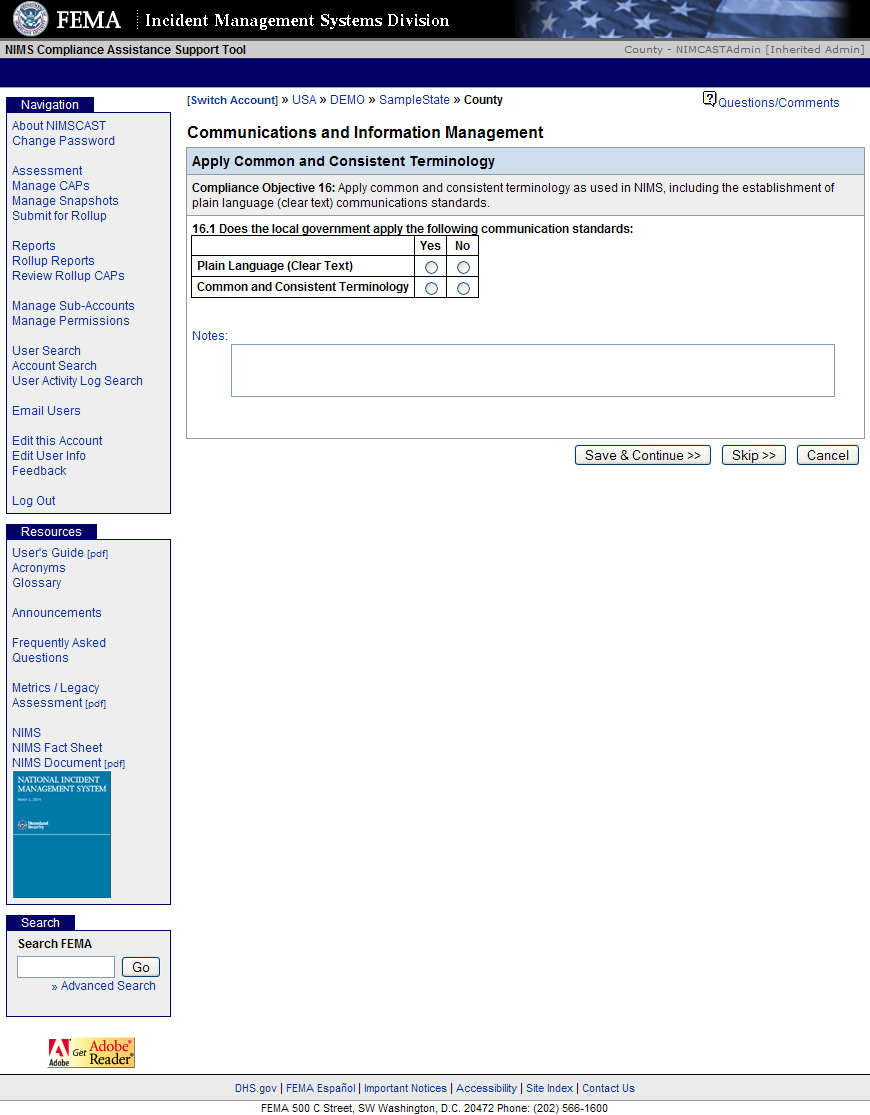
2007 Section 7 Question 1
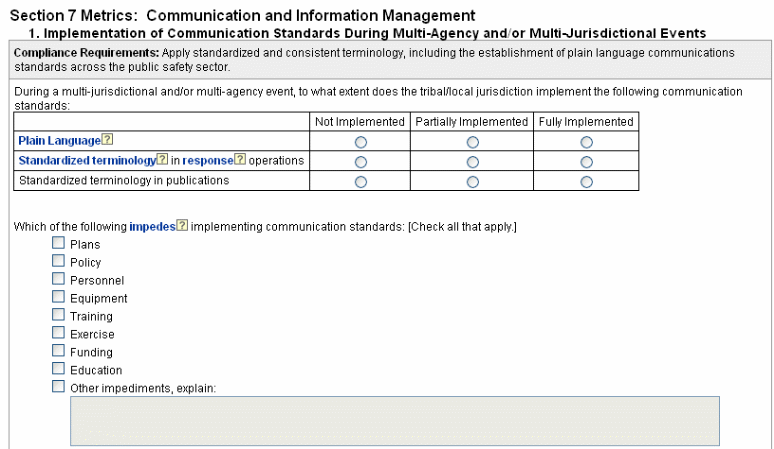
The focus of 2008 Section 16 Question 1 is the application of two communication standards, Plain Language and Common and Consistent Terminology by the local government. 2007 Section 7 Question 1 broadens the concern to the condition of implementation. These conditions being “Not Implemented”, “Partially Implemented” and “Fully Implemented” Again, as with previous questions, an optional checklist for impediments to implementation is provided for respondents.
2008 Section 17 Question 1

2007 Section 7 Question 2

2008 Section 17 Question 1 asks respondents to indicate whether the local government uses systems, tools and processes to present consistent and accurate information during an incident or planned event. Two columns are given to indicate “yes” or “no”.
2007 Section 7 Question 2 presents a different format for respondents to give indication.
The selection table is divided into three rows to convey systems, tools and processes, this time with the concerns of communications, intelligence, information management, information sharing and resource status.
2008 Section 18 Question 1

2007 Section 6 Question 1

The wording of 2008 Section 18 Question 1 has been reconfigured from the phrasing of 2007 Section 6 Question 1. “Management/incident response assets” has become “response resources”. 2007 also provides a checklist for impediments.
2008 Section 18 Question 2

2007 Section 6 Question 3

2008 Section 18 Question 2 shortens the inquiry or 2007 Section 6 Question 3.
The shortened version is paraphrased into one question, while the question of 2007 is presented as a two part inquiry. The two parts, resource typing and response assets correspond to the one part inquiry of 2008, the main concern being response assets.
2008 Section 18 Question 3

2007 Section 6 Question 6

2008 Section 18 Question 3 has abbreviated the format given in 2007 Section 6 Question 6. While “Tier One” compliance is a condition in 2008. No mention is made of this in 2007. Instead, 2007 provides a three part inquiry, with the third part divided further into response options.
2008 Section 19 Question 1

2007 Section 6 Question 7

2008 Section 19 Question 1 departs from the presentation of 2007 Section 6 Question 7.
2008 divides the response into four choices in which respondents must indicate “yes” or
“no”. 2007 differs in that it divides the question into three choices, but asks respondents to give explanation if the answer is no.
2008 Section 20 Question 1

2007 Section 6 Question 4

2008 Section 20 Question 1 shortens the response table given for respondents from the extended form given in 2007 Section 6 Question 4. While 2008 deals with the interoperability of equipment, communications and data systems, 2007 focuses on the condition of these interoperable standards. Those conditions being not required, partially required and fully required.
2008 Section 20 Question 2

2007 Section 6 Question 5

2008 Section 20 Question 2 has changed the format for respondents to give response from the previous format given in 2007 Section 6 Question 5. Respondents are given the elements to which they must respond with an answer of “yes” or “no”.
2007 differs in that it focuses on resource typing and response assets.
Respondents are asked to explain further if the response to response assets is no.
2008 Section 21 Question 1

2008 Section 21 Question 1 is an entirely new section added in 2008 and has no counterpart is 2007.
2008 Section 22 Question 1

2007 Section 2 Question 1

Again 2008 has been shortened from the format of 2007. Both are primarily concerned with the implementation of ICS by local governments. 2007 Section 2 Question 1 differs from 2008 Section 22 Question 1 in that 2007 is more inclusive of explanations for impediments which respondents must give indication.
2008 Section 22 Question 2

2007 Section 2 Question 2

2008 Section 22 Question 2 divides the optional response for respondents into fourteen concepts. This departs from the two part inquiry of 2007 Section 2 Question 2, where the focus is upon preplanned events in the first part and impediments in the second part.
The second part is divided into six options that may apply to the answer “no”.
2008 Section 22 Question 3

2007 Section 2 Question 3

2008 Section 22 Question 3 mentions the implementation of Incident Action Plan during incidents or planned events. 2007 Section 2 Question 3 differs in that it mentions the Incident Action Plan in connection with ICS. 2008 doesn’t mention ICS in the question, itself. Again, 2007 provides a checklist of possible responses for responders.
2008 Section 22 Question 4

2007 Section 2 Question 4

2008 Section 22 Question 4 asks if the local government has implemented common communication plans during incidents or planned events.
2007 Section 2 Question 4 mentions these plans in connection with ISC.
2008 doesn’t mention ICS in the question itself. 2007 asks respondents to indicate from a list of seven options the reason implementation might be impeded. 2008 has no such list.
2008 Section 23 Question 1

2007 Section 2 Question 5

2008 Section 23 Question 1 divides the inquiry into two parts. The first part asks if the local government uses the Multi-agency Coordination System during incidents and planned events. Respondents are given the options of “yes” or “no” for response.
The second part gives respondents a choice of seven options in response to the issue of primary functions. 2007 Section 2 Question 5 presents a different format from 2008.
Five concepts are listed in which respondents must indicate “yes” or “no”. If the response should be “no” for any of the concepts, respondents are then required to explain the reason.
2008 Section 24 Question 1

The last inquiry of 2008 Section 24 Question 1 is entirely new and has no counterpart in 2007.
2007 Section 2 Questions 6 through 10
2.6

2.7

2.8

2.9

2.10

2008 Section 24 Question 1 departs from the very extensive format of 2007.
While 2008 is divided into four inquiries with answer options for “yes” or “no”,
2007 Section 2 Questions 6 through 10 lists a number of concepts per individual table to which respondents must answer “yes” or “no” and are required to explain the reason for the choice of “no”. Some of the tables of 2007 also list functions or concepts to which respondents must give indication of choices. This extensive concept listing is eliminated in 2008.
2008 Section 25 Question 1

2007 Section 2 Question 11

2008 Section 25 Question 1 alters the format of 2007 Section 2 Question 11.
2007 is broader in scope to include types of information. Respondents are asked to click all that apply. Four columns are given where respondents must read horizontally to apply indication. 2008 lists options vertically where respondents must indicate “yes” or “no”.
| File Type | application/msword |
| File Title | 2008 Section 1 Question 1 |
| Author | FEMA Employee |
| Last Modified By | FEMA Employee |
| File Modified | 2008-04-24 |
| File Created | 2008-04-16 |
© 2026 OMB.report | Privacy Policy